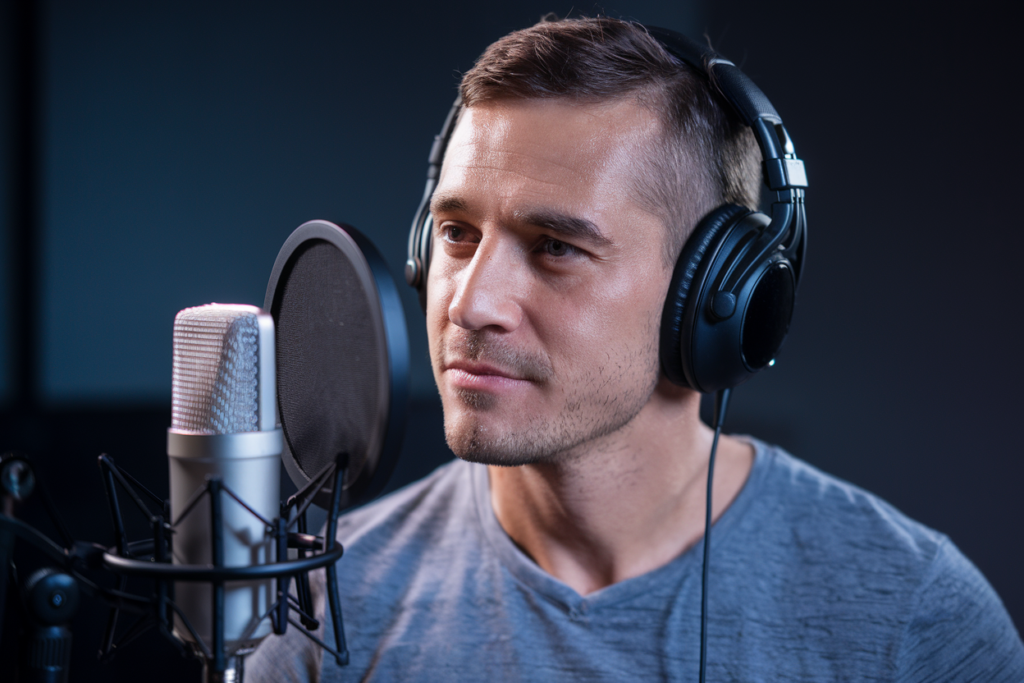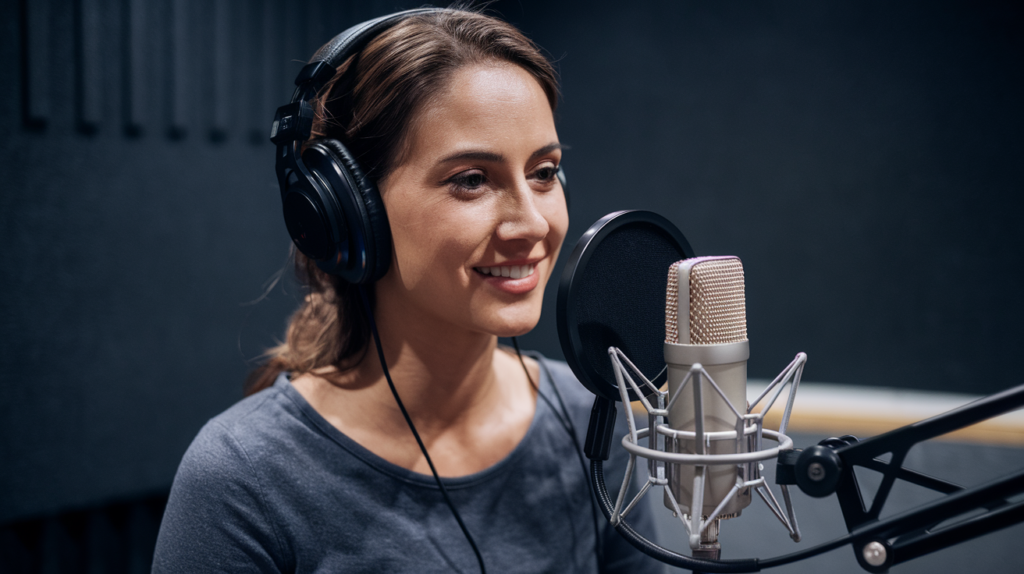Key Takeaways
- Diverse Accents and Dialects: Romania’s voiceover industry is characterized by various regional accents, such as Transylvanian, Moldovan, and Muntenian, each adding unique flavors to voice projects.
- Cultural Authenticity: Engaging local voice talent enhances cultural authenticity and relatability in content, allowing for deeper connections with target audiences.
- Economic Value: Utilizing regional variations can increase audience engagement and brand loyalty, ultimately driving economic growth within the Romanian creative industry.
- Technical Considerations: High-quality recording equipment is essential for capturing the subtle nuances of different dialects to maintain authenticity in voiceovers.
- Future Trends: There’s a rising demand for authentic voices that reflect local dialects, supported by advancements in technology that improve sound quality while preserving the human touch.
Ever wondered why some Romanian voiceovers sound so different depending on where you are? With its rich tapestry of regional accents and dialects, Romania offers a fascinating landscape for voiceover artists. Understanding these regional variations isn’t just interesting—it’s essential if you want to connect authentically with your audience.
Overview of Romanian Voiceover Industry
The Romanian voiceover industry showcases a rich tapestry of regional accents and dialects. Understanding these variations is crucial for anyone seeking to connect with the local audience. Different regions, like Transylvania or Moldavia, bring unique flavors to voiceovers that resonate differently with listeners.
Voice artists in Romania leverage their skills to adapt to these regional nuances. This adaptability enhances their appeal when targeting specific demographics or projects. For instance, a voice actor from Bucharest might deliver a polished corporate read, while one from Cluj could infuse warmth into an animated character.
Additionally, the demand for diverse voice talents has surged due to globalization and increased media consumption. As businesses look for authentic connections in their marketing efforts, hiring the right voice over talent becomes essential. Whether it’s commercials, audiobooks, or e-learning modules, selecting a voice over artist who understands regional subtleties can make all the difference.
With a growing number of professionals entering this field, the competition remains fierce but rewarding. Voice actors often collaborate across various platforms and genres, allowing them to showcase their versatility while catering to client needs effectively.
Engaging with local talent not only supports cultural authenticity but elevates your project’s overall quality. So when considering your next project in Romania, think about how choosing the right voice over professional can enhance your message and captivate your audience.
Importance of Regional Voiceover Variations
Understanding regional voiceover variations plays a crucial role in creating authentic connections with audiences. These nuances not only reflect cultural diversity but also enhance the relatability of your projects.
Cultural Significance
Cultural significance shapes how you communicate through voiceovers. Each region in Romania has its distinct dialects and accents, reflecting local traditions, histories, and values. By incorporating these variations into your voiceovers, you resonate more deeply with specific demographics. For instance, a voice artist familiar with Transylvanian accents can evoke familiarity among local listeners while enhancing the authenticity of storytelling.
Engaging a voice actor who understands these cultural subtleties enriches the listening experience. It allows for a genuine portrayal that captures the essence of Romanian culture, making your content more engaging and impactful.
Economic Impact
The economic impact of regional voiceover variations cannot be overstated. As media consumption expands globally, businesses recognize the value in hiring localized voice talent to reach their target markets effectively. Tailoring your projects with suitable voice over talent increases audience engagement and boosts brand loyalty.
Investing in diverse voice artists creates opportunities for businesses to stand out in competitive markets. Clients appreciate when they hear an authentic local accent; it builds trust and enhances brand perception. Utilizing regional variations can lead to improved conversion rates as audiences feel recognized and valued.
Incorporating regional distinctions into your projects not only elevates quality but also drives economic growth within the Romanian creative industry through increased demand for skilled professionals who excel at delivering nuanced performances.
Key Regional Variations in Romanian Voiceover
Romania showcases a rich tapestry of regional voiceover variations, each contributing unique flavors to the language. Understanding these nuances is essential for voice artists aiming to resonate with their audience effectively.
Transylvanian Dialect
The Transylvanian dialect stands out due to its distinct intonations and phonetics. Characterized by soft consonants and melodic tones, this dialect often evokes a sense of folklore and tradition. Voice actors familiar with the Transylvanian accent can bring authenticity to narratives that draw on Romania’s cultural heritage. This familiarity enhances projects targeting audiences who appreciate local stories or historical contexts.
Moldovan Dialect
Moldovan dialect features a blend of influences, including Romanian and Russian elements. Its rhythmic cadence makes it appealing for various media projects, from commercials to audiobooks. Voice talents adept in this dialect can capture the essence of Moldovan culture while engaging listeners with relatable storytelling. This variation is particularly effective when addressing communities that identify closely with Moldova’s unique identity.
Muntenian Dialect
Muntenian dialect, prevalent in southern Romania, boasts a dynamic range of sounds and expressions. With its straightforward enunciation and vibrant energy, this dialect suits diverse genres—from animated characters to serious documentaries. A voice artist skilled in this area can convey emotions authentically while connecting deeply with target demographics seeking genuine representation in their content.
Embracing these regional variations amplifies your project’s appeal, ensuring it resonates on multiple levels with Romanian-speaking audiences. Engaging voice talent trained in these specific accents not only fosters relatability but also enriches the overall narrative experience.
Challenges in Regional Voiceover
Voiceovers in Romania present unique challenges due to the country’s diverse regional accents and dialects. Navigating these differences requires a deep understanding of each variation, as it influences how voice artists connect with their audience.
Technical Limitations
Technical limitations can hinder the effectiveness of voiceovers. For instance, some recording equipment may not capture the subtle nuances of specific dialects, leading to a loss of authenticity. Inconsistencies in sound quality across different regions can also affect how well your message resonates. It’s essential for voice talent to use high-quality gear and studio environments that accommodate various vocal characteristics, ensuring clarity and precision in every performance.
Audience Perception
Audience perception plays a crucial role in regional voiceover success. Listeners often have strong emotional ties to their local dialects; they might feel more connected to content that reflects their own speech patterns. A voice artist who masters the subtleties of these variations can evoke familiarity and trust, enhancing engagement with your project. Understanding cultural context is vital—what works for one region may not resonate as effectively in another. Tailoring your approach based on audience preferences ensures that you maximize relatability and impact through effective storytelling.
By addressing technical limitations and being attuned to audience perception, you can navigate the complexities of regional voiceovers successfully. This attention to detail fosters deeper connections between your content and listeners, ultimately elevating the overall experience.
Future Trends in Romanian Voiceover
The Romanian voiceover landscape is evolving rapidly, driven by shifting audience preferences and technological advancements. Staying ahead of these trends ensures you connect effectively with your target market.
Increasing Demand for Authenticity
There’s a growing emphasis on authenticity in voiceovers. Audiences crave genuine connections, often resonating more with voice artists who reflect their local dialects and cultural nuances. You’ll find that hiring voice talent familiar with specific regional variations enhances the relatability of your projects. An authentic voice can evoke trust and familiarity, making your content more engaging. In today’s diverse media environment, choosing a skilled voice actor who embodies cultural specifics isn’t just beneficial; it’s essential for successful communication.
Role of Technology
Technology plays a crucial role in shaping the future of Romanian voiceovers. High-quality recording equipment allows for better capture of subtle dialect nuances, ensuring authenticity shines through in every project. Moreover, advancements in AI and speech synthesis are changing how you approach casting decisions. While technology offers exciting possibilities for efficiency, human touch remains irreplaceable—real-life experiences and emotional depth delivered by a professional voice artist can’t be replicated digitally. By embracing both traditional methods and modern innovations, you can enhance the quality of your audio productions while meeting audience expectations effectively.
Exploring these trends will help you navigate the dynamic landscape of Romanian voiceovers successfully, ensuring your projects resonate deeply with listeners across various demographics.
Conclusion
Understanding regional voiceover variations in Romanian is crucial for anyone looking to engage effectively with audiences. By appreciating the unique characteristics of dialects like Transylvanian, Moldovan, and Muntenian, you can enhance your storytelling and connect on a deeper level.
This awareness not only elevates project quality but also supports cultural authenticity in your work. As demand for localized content continues to grow it’s essential to partner with voice talent who truly grasp these nuances. Embracing these regional differences will undoubtedly set you apart in an increasingly competitive landscape while building trust and loyalty among your audience.
Frequently Asked Questions
What are the main regional dialects in Romanian voiceovers?
The main regional dialects in Romanian voiceovers include Transylvanian, Moldovan, and Muntenian. Each has unique characteristics: Transylvanian features distinct intonations linked to folklore, Moldovan has a rhythmic cadence influenced by both Romanian and Russian, while Muntenian is dynamic and versatile for various genres.
Why is understanding regional accents important for voiceover artists?
Understanding regional accents is crucial for voiceover artists as it helps them connect authentically with their audience. Familiarity with local variations allows voice talent to evoke trust and relatability, enhancing the overall narrative experience in projects aimed at specific demographics.
How do regional variations impact audience engagement?
Regional variations significantly impact audience engagement by fostering familiarity and cultural connection. Listeners are more likely to resonate with content that reflects their local speech patterns, which enhances relatability and boosts brand loyalty among target markets.
What challenges do voiceover professionals face with regional accents?
Voiceover professionals encounter challenges such as technical limitations in recording equipment that may not capture subtle dialect nuances. Additionally, they must navigate audience perceptions; listeners often prefer voices that mirror their own speech patterns for a stronger emotional connection.
What future trends are emerging in the Romanian voiceover industry?
Future trends in the Romanian voiceover industry include a growing demand for authenticity, driven by shifting audience preferences. Technology advancements like high-quality recording tools and AI are changing casting decisions, but the human touch remains essential for delivering emotional depth in performances.







